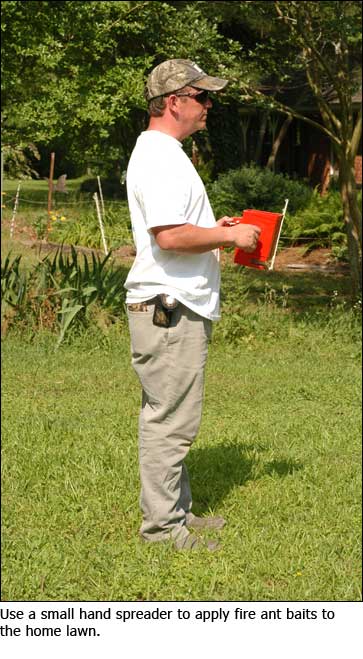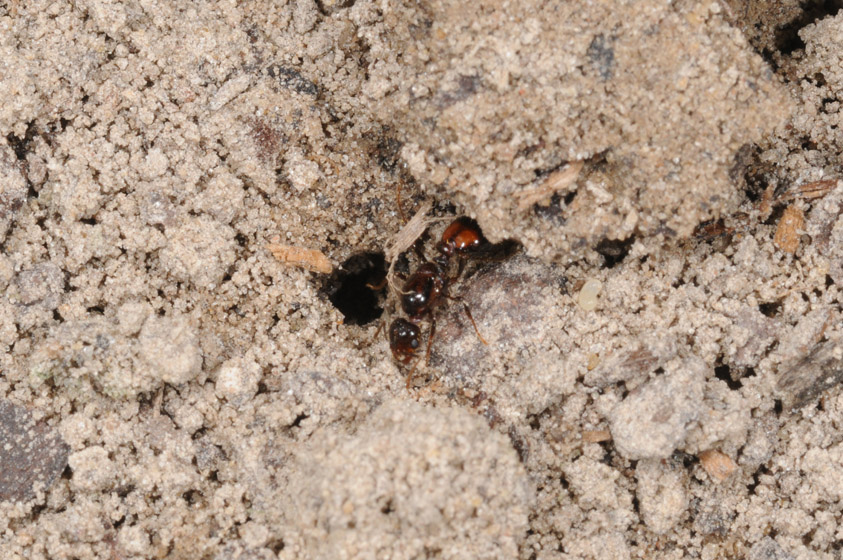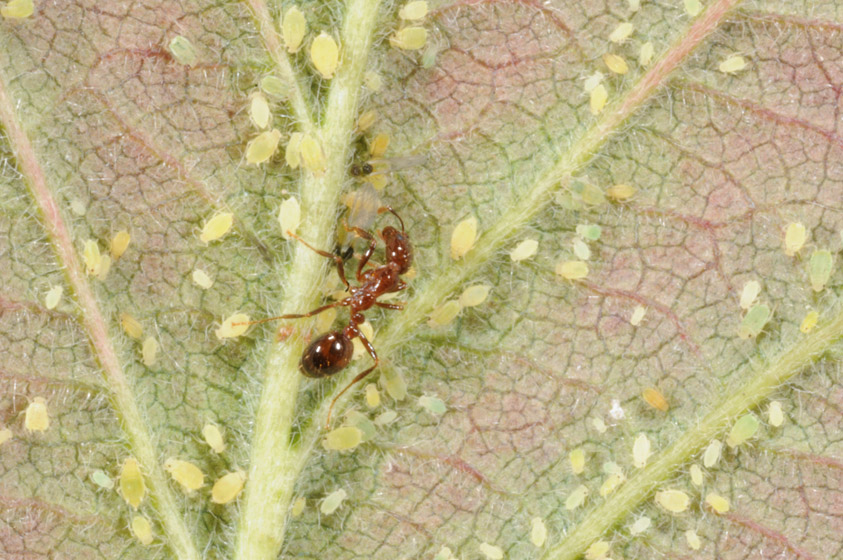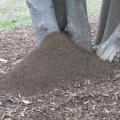Fire Ant Biology

If you want to control fire ants, it helps to know a little about their biology. Understand fire ant biology and you will understand why baits work so well to control fire ants and why it’s important to spread bait throughout the yard (Figure 1), rather than just putting it directly on top of the mound. You will also understand why it’s so frustrating and ineffective to try to control this pest by only treating the mounds you can see. And you will learn why, no matter how good a job you do controlling fire ants, they always come back. The biology of the red imported fire ant and the black imported fire ant is similar.
Fire ants are social, colony-forming insects. Although most fire ant colonies have only one reproducing queen, multi-queen colonies are common in some areas. In addition to the queen, or queens, an established colony contains many thousands of workers, many hundreds of virgin male and female reproductives, and many thousands of eggs and immature ants. A mature fire ant colony may contain over 200,000 individuals.
Life Cycle
The eggs, which are only produced by the queen, hatch into legless larvae that must be constantly cared for by the workers. The larvae undergo four molts before entering the pupal stage, and ultimately emerging as adults.
Despite their helpless condition, the larvae make an important contribution to the welfare of the colony—older larvae are the only individuals in the colony capable of digesting solid food. Workers bring all solid food particles to the older larvae, and, after this solid food is digested by the larvae, the resulting liquid is distributed to all members of the colony. Unlike honeybee colonies, fire ant colonies do not contain any physical structures for storing food. Food is stored inside the ants themselves, especially in the crops of larger workers.
Fire ant workers vary greatly in size. There is some task specialization, with larger workers more commonly performing certain tasks such as foraging and food storage, while smaller workers most commonly tend brood, but there is also considerable overlap, especially among medium sized workers. Reproductive females and males are considerably larger than even the largest workers. Reproductive males are darker than females and have much smaller heads.
Mound Construction
Workers build mounds by tunneling through the soil to form a honeycombed maze of tunnels. They pile the excavated soil immediately above the soil line and form tunnels in this soil as well. This results in an above ground mound that can collect warmth from the sun and provide drier conditions and an underground series of galleries that provide cooler, moister conditions. Fire ants use this to their advantage by continually moving brood to the area of the nest that provides the most suitable environment. During cool wet periods this may be the above ground portion of the nest, while during hot dry periods the brood and the majority of the colony members will remain in the deeper underground galleries.
The height and visibility of fire ant mounds varies with weather and temperature. During cool wet periods the workers will build the mound high above the soil, so they can keep the brood warm and dry. During hot dry periods they tend to stay deeper in the soil, so they can keep the brood cool and moist, and even large colonies may not be visible above the grass. This is why fire ants often seem to be more abundant in early spring. Not only are mounds taller at this time, but vegetation is shorter, making mounds more conspicuous.
Where is the door? Normally, there are no external openings in the top of the mound. Foraging ants enter and exit the nest through an array of foraging tunnels that are located slightly below the soil surface and extend in all directions from the mound. These forage tunnels eventually exit to the soil surface several feet away from the nest.
Swarming
An exception to the absence of external openings in the top of the mound occurs when a colony swarms. Swarming is the way fire ant colonies reproduce themselves. Workers break openings through the crust of soil on top of the mound and winged, unmated male and female reproductives exit the mound. These unmated males and females take flight and mate in the air, often several hundred feet above the ground. Swarming occurs from spring through late fall. Swarms are especially common one to two days after a rain event that has been preceded by a dry period.
After they have mated the young queens settle back to the ground, shed their wings, and begin to establish a new colony (Figure 2). They do this by digging a small tunnel a couple of inches into the soil, sealing the opening, and beginning to lay eggs. During this time the queen subsists on nutrients derived from the breakdown of her wing muscles.

The workers that emerge from the first eggs are unusually small, but they are able to assist the queen in producing more brood, and they also begin foraging for food and expanding the nest. Most young queens attempting to establish new colonies are unsuccessful. They are eaten by a variety of predators, including foraging workers from fire ant colonies, and many simply perish due to inadequate resources. A successful colony can grow to over 100,000 individuals, and begin producing swarms of its own, in six to nine months.
During the mating flight, air currents can carry winged ants considerable distances from their original colony and this is one of the main ways fire ants expand their range. Sometimes man unwittingly helps transport newly mated queens or established colonies of fire ants over long distances. That’s how fire ants got here in the first place. They were brought to the Port of Mobile by boat, probably in soil used as ballast. Accidental transport of fire ants is a possibility any time soil-containing items, such as sod or potted plants, are transported from fire ant infested areas. USDA maintains a quarantine to minimize this potential.
Feeding and Foraging Behavior
Fire ants are omnivorous and feed on a wide variety of plant and animal material. They are active predators and scavengers, eating any live insects they are able to capture as well as dead insects. They also ‘tend’ aphids (Figure 3), scale insects, and other homopterous insects for the honeydew they produce.

Fire ants also prey on small, ground-dwelling vertebrates, including mammals, such as mice, ground-nesting birds, and ground dwelling reptiles and amphibians. In most cases it is the hatching eggs or helpless, immobile young that are attacked. Several studies have shown the abundance of ground-dwelling animals declines significantly when there are high densities of imported fire ants. Fire ants also opportunistically feed on carcasses of larger animals and will attack sick or injured animals that have become immobile. Although fire ants rarely feed on plant foliage, they do feed on plant exudates, and they actively forage for fruit and seed, and occasionally feed on the inner bark of shrubs and trees. Seed are an especially favored food source, because of their high protein and oil content.
It’s the older workers that do the foraging, leaving the colony through tunnels that radiate from the mound. These tunnels usually run just below the soil surface and exit to the surface some distance away from the colony, usually within five to 20 feet. But in hard or gravely soils foraging tunnels sometimes run along the surface. Upon exiting, foraging workers fan out in search of food. When traveling along the surface, workers use chemicals exuded from the tip of their abdomen to lay a chemical trail they can follow back to the mound.
Workers that are successful in locating a large food source recruit other workers by exchanging bits of the food with them and by laying a return trail from the source. As additional workers follow this trail they enhance it with scent of their own, and this recruits even more workers. Thus, a substantial food source can attract a large, steady stream of foraging workers in a relatively short period of time. If you want to see just how fast fire ant workers will recruit to a food source, just lay a greasy potato chip on the ground in a fire ant infested area and check it ten to fifteen minutes later.
Adult fire ants are not capable of eating solid foods; they have a sieve-like structure in their throat that prevents them from swallowing solids. Solid food particles are carried back to the colony and fed to the older larvae, which are capable of converting them to liquids. The larvae then regurgitate this liquid food to the tending workers who pass it to other workers, as well to the queen and younger larvae. This process is known as trophalyxis, and it is also common in other social insects, like termites and honeybees. This habit of sharing food among all members of the colony is the main reason baits are such an effective way to control fire ants.
Contact information for Dr. Blake Layton.
Publications
News
Sunshine and long days make summertime in the South desirable for people, but those same conditions are exactly what allows the dreaded, imported fire ants to thrive.
Almost any sunny, grassy area left unattended will soon be home to fire ants. Fire ants were accidentally imported from South America to Mobile in the 1930s and have since spread throughout the Southeast.
Everyone loves a good myth buster, and we have a very timely one for you! Fire ant beds in your yard can be such a headache to deal with. Many people have used home remedies to control ants. But are those quick fixes really getting rid of the ants in your yard? Let’s take a look at some commonly used home remedies and whether or not they work!
Do you have fire ants in your vegetable garden? Me too. Good news for all of us! There are some fire ant baits that are safe to use around food plants.



